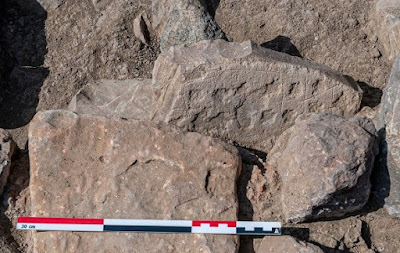I have, in
the past, written a few columns about petroglyphs that seem to be intended as
game boards. There is now a new report about another one found in Oman by a
joint project between the University of Warsaw and the Omani Ministry of
Heritage and Tourism.
“The work is carried out by an Omani-Polish project ‘The development of settlement in the mountains of northern Oman in the Bronze and Iron Ages’ headed jointly by Prof. Piotr Bielinski from the Polish Centre of Mediterranean Archaeology, University of Warsaw (PCMA UW) and Dr. Sultan al-Bakri, Director General of Antiquities at the Ministry of Heritage and Tourism (MHT) of the Sultanate of Oman.” (ASZY 2022)
Oman is located on the southeast tip of the Arabian Peninsula adjacent to the Indian Ocean and the ruins are near the village of Ayn Bani Saidah in the Qumayrah Valley in the north of the Sultanate of Oman. (ASZY)
“In the latest study, the researchers identified an ancient settlement from the Umm al-Nar period (2500-2000 BC), where they unearthed the remains of several large circular towers and Bronze Age buildings.” (HeritageDaily 2022)
“In one of the rooms we’ve found…a game-board – beams the project director. The board is made of stone and has marked fields and cup-holes. Games based on similar principles were played during the Bronze Age in man economic and cultural centers of that age. Such finds are rare, but several examples are known from India, Mesopotamia and even the Eastern Mediterranean basin.” (ASZY 2022) Unfortunately, none of the references identified which of the co-directors of the project this quotation should be attributed to.
The board appears to have 14 holes carved into what looks in the photos to be a block of limestone. It seems to be intended for use in a variant of the family of games known as Mancala in which seeds or stones are moved from pit to pit to either capture an opponent’s pieces, or to bank the most pieces for yourself. (Wikipedia)
“Researchers also found evidence of processing copper at the site, as well as several copper objects, suggesting that the settlement participated in this lucrative trade for which Oman was famous at that time, with mentions of Omani copper present in the cuneiform texts from Mesopotamia.” (HeritageDaily 2022)
I think that we can assume that any group of people who have the leisure time to play board games are, if not prosperous, at least secure in their environment, and emotionally relaxed enough to enjoy themselves, and this game board would seem to prove this. I can picture prosperous copper merchants relaxing with a game of mancali. There is, however, another possibility, that this is a counting board. These work on the same principle as an abacus with each hole in each marked off sector having a value. The operator can essentially do fairly complicated mathematical operations by placing, moving, or removing counters between the various valued holes. If this were the case we need to picture the prosperous copper merchants calculating their profits. Remembering, however, that the board appears to have 14 holes I know of no mathematical system that would require 14 holes to work.
NOTE: Some images in this posting were retrieved from the internet with a search for public domain photographs. If any of these images are not intended to be public domain, I apologize, and will happily provide the picture credits if the owner will contact me with them. For further information on these reports you should read the original reports at the sites listed below.
REFERENCES:
ASZY, 2022, Qumayrah Valley in Oman: ancient towers, copper trade and games, 4 January 2022, Polish Centre of Mediterranean Archaeology, University of Warsaw, accessed 8 January 2022
HeritageDaily, 2022, Archaeologists discover 4,000-year-old stone board game, https://www.heritagedaily.com, accessed 7 January 2022.
Wikipedia, Mancala, https://en.wikipedia.org/wiki/Mancala,
accessed 9 January 2022







No comments:
Post a Comment